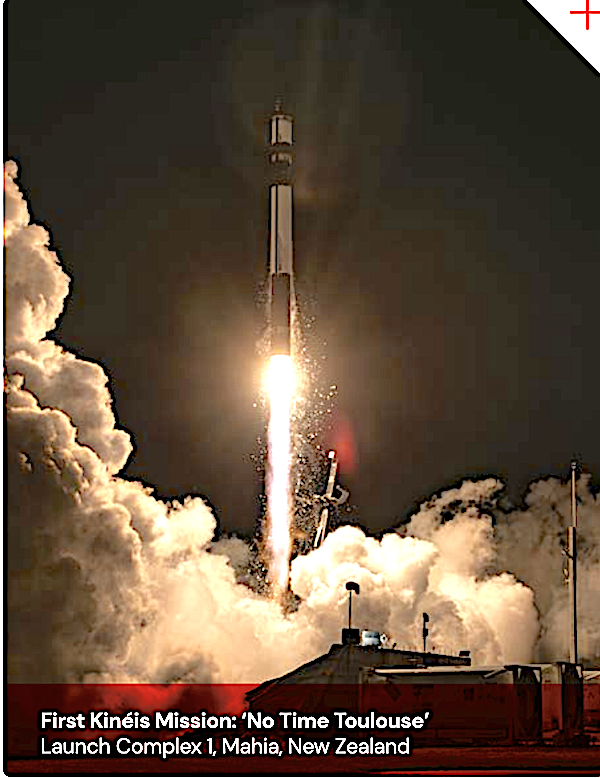
Rocket Lab is scheduled to launch its fourth batch of five satellites for the French Kinéis IoT constellation designed to operate with 25 nanosatellites of 30 kg each at a cost of $6 Million.
The launch will take place at 12:43 pm PST from Rocket Lab’s private orbital launch site, Launch Complex 1, in New Zealand. The mission is the fourth of five dedicated Electron launches booked by Kinéis in a multi-launch contract that will see Rocket Lab deploy an entire constellation of 25 IoT satellites. The first three missions were successfully launched by Electron in June, September and November 2024.
Weather is a challenge with a forecast that calls for a temperature of 63°F, overcast clouds, 99% cloud cover and a wind speed of 7mph.
Thanks to its constellation of 25 nanosatellites, Kinéis can connect any object from anywhere in the world and transmit useful data from these objects to users in near real time. This data is a decision-making tool that can be used to optimize activities while reducing risks, thanks to three essential functions: tracking, monitoring and alerting.
Kinéis’ space connectivity applications are used in a number of fields that represent major challenges for humankind: natural risk prevention (detection of forest fires, floods, pollution, etc.), monitoring of infrastructure and energy networks (detection of anomalies, predictive maintenance, etc.), transport and logistics monitoring agriculture, traceability of wild and farmed animals, and monitoring of agriculture activities.
The Kinéis constellation also integrates the AIS (Automatic Identification System), a maritime automatic identification system for ships operating on VHF (Very High Frequency) radio frequencies, which enables ship and surveillance systems to know the identity, position, direction and status of ships at sea.
Kinéis’ satellite-based AIS (S-AIS) is a high-performance system (requiring no ground infrastructure) that complements terrestrial AIS, enabling ships to be monitored worldwide, even in international waters not accessible by terrestrial AIS.
Rocket Lab’s launch of IoT 4 You and Me Kinéis 16-20 Monday

IOT 4 You and Me Rocket Lab is scheduled to launch Fourth batch of five satellites for the French Kinéis IoT constellation designed to operate with 25 nanosatellites of 30 kg each on Monday, February 3, at 12:43 pm PST.
The launch will take place from Rocket Lab’s private orbital launch site, Launch Complex 1, in New Zealand. The forecast calls for a temperature of 64°F, clear skies, 8% cloud cover and a wind speed of 16mph.

The mission is the fourth of five dedicated Electron launches booked by Kinéis in a multi-launch contract that will see Rocket Lab deploy an entire constellation of 25 IoT satellites. The first three missions were successfully launched by Electron in June, September and November 2024.
“IOT 4 You and Me” is Rocket Lab’s first scheduled launch of 2025, with the company expecting this year to exceed its record-breaking launch cadence of 16 launches across Electron and HASTE achieved in 2024.
Created in 2018, Kinéis is a satellite operator and global connectivity provider. It inherited 40 years of expertise in the Argos system, founded by CNES (French space agency) and historically operated by CLS (Collecte Localisation Satellites). Its mission is to develop reliable technology that provides easy access to useful satellite data.
Thanks to its constellation of 25 nanosatellites, Kinéis can connect any object from anywhere in the world and transmit useful data from these objects to users in near real time. This data is a decision-making tool that can be used to optimize activities while reducing risks, thanks to three essential functions: tracking, monitoring and alerting.
Rocket Lab’s launch of IoT 4 You and Me (Kinéis 16-20) scheduled February 4


The “IOT 4 You and Me” mission is scheduled to launch during window that opens on February 4th NZDT. Within the multi-day window, there is an instantaneous launch opportunity daily at 09:43 am NZDT (20:43 UTC).
The launch will take place from Rocket Lab’s private orbital launch site, Launch Complex 1, in New Zealand. The mission is the fourth of five dedicated Electron launches booked by Kinéis in a multi-launch contract that will see Rocket Lab deploy an entire constellation of 25 IoT satellites. The first three missions were successfully launched by Electron in June, September and November 2024.
“IOT 4 You and Me” is Rocket Lab’s first scheduled launch of 2025, with the company expecting this year to exceed its record-breaking launch cadence of 16 launches across Electron and HASTE achieved in 2024.
Created in 2018, Kinéis is a satellite operator and global connectivity provider. It inherited 40 years of expertise in the Argos system, founded by CNES (French space agency) and historically operated by CLS (Collecte Localisation Satellites). Its mission is to develop reliable technology that provides easy access to useful satellite data.
Thanks to its constellation of 25 nanosatellites, Kinéis can connect any object from anywhere in the world and transmit useful data from these objects to users in near real time. This data is a decision-making tool that can be used to optimize activities while reducing risks, thanks to three essential functions: tracking, monitoring and alerting.
Kinéis’ space connectivity applications are used in a number of fields that represent major challenges for mankind, its activities and its environment today: natural risk prevention (detection of forest fires, floods, pollution, etc.), monitoring of infrastructures and energy networks (detection of anomalies, predictive maintenance, etc.), transport and logistics monitoring, agriculture, traceability of wild and farmed animals, and monitoring of commercial and leisure maritime activities.
The Kinéis constellation also integrates the AIS (Automatic Identification System), a maritime automatic identification system for ships operating on VHF (Very High Frequency) radio frequencies, which enables ships and surveillance systems to know the identity, position, direction and status of ships at sea.
Kinéis’ satellite-based AIS (S-AIS) is a high-performance system (requiring no ground infrastructure) that complements terrestrial AIS, enabling ships to be monitored worldwide, even in international waters not accessible by terrestrial AIS.
